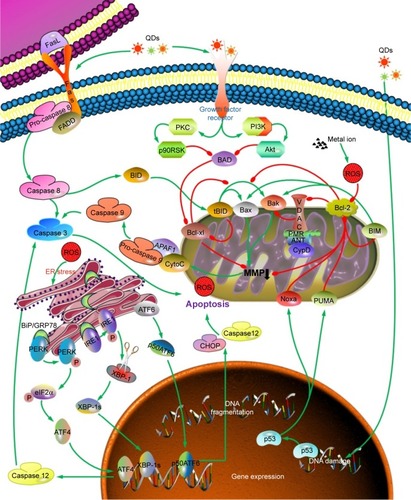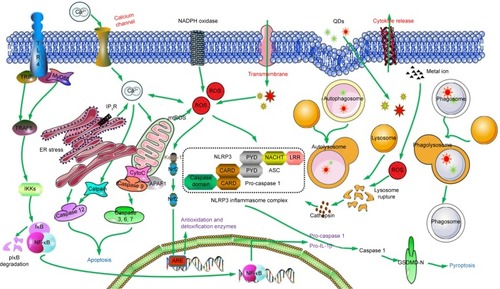Figures & data
Figure 1 The basic structure of QD is composed of a core and a shell.
Note: It can also be designed for the purpose of enhancing biocompatibility with addition of variable outer layers, such as peptides, antibodies, oligonucleotides and so on.
Abbreviation: QD, quantum dot.

Figure 2 Scheme of the proposed mechanisms through which QDs disrupt the cellular homeostasis and induce apoptosis.
Note: Green line represents activation, while the red line represents inhibition.
Abbreviations: ANT, adenine nucleotide transporter; ATF4, activating transcription factor 4; ATF6, activating transcription factor 6; Bak, Bcl-2 antagonist/killer 1; Bax, Bcl-2-associated X protein; Bcl-2, B-cell lymphoma-2; Bcl-xl, B-cell lymphoma-extra large; BID, BH3 interacting domain death agonist; BAD, BCL2 associated agonist of cell death; BIM, BCL2 like 11; BiP, binding immunoglobulin protein; CHOP, CCAAT/enhancer-binding protein homologous protein; CypD, cyclophilin D; ER, endoplasmic reticulum; FADD, Fas associated via death domain; FasL, Fas ligand; IRE1, endoplasmic reticulum to nucleus signaling 1; MMP, mitochondrial membrane potential; QDs, quantum dots; PERK, protein kinase RNA-like ER kinase; PKC, protein kinase C; PUMA, protein p53 upregulated modulator of apoptosis; ROS, reactive oxygen species; VDAC, voltage dependent anion channel; XBP-1, X-box binding protein 1; XBP-1s, spliced XBP-1.

Figure 3 The signaling pathways and the possible mechanisms of QDs in cytotoxicity.
Note: Incubation with QDs could induce cellular processes, which could be triggered by several signal transductions, incorporating detoxification of Nrf2-ARE pathway, inflammatory reaction of TLRs/NF-κB and NLRs pathways.
Abbreviations: ARE, antioxidant response element; APAF1, apoptotic protease activating factor-1; CARD, caspase activation and recruitment domain; ER, endoplasmic reticulum; GSDMD, gasdermin D; IL, interleukin; IKK, IκB kinase; IκB, inhibitor of κB; NF-κB, nuclear factor kappa-light-chain-enhancer of activated B cells; NLRs, nucleotide oligomerization domain-like receptors; mtROS, mitochondrial ROS; Nrf2, nuclear factor (erythroid-derived 2)-like 2; QDs, quantum dots; ROS, reactive oxygen species; TLRs, Toll-like receptors.

